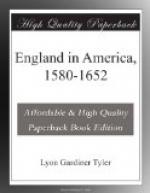Upon the question of appointment of a commander-in-chief colonial independence came in conflict with federal supremacy. In 1637 Massachusetts was the champion of the principle that all questions should be decided by a simple majority vote of the commissioners; but now the Massachusetts general court asserted that no appointment of a commander should be valid without their confirmation. The federal commissioners stood stoutly for their rights, and the issue was evaded for a time by the appointment of Major Gibbons, who was a citizen of Massachusetts.
The report of these warlike preparations brought the Narragansetts to terms; but uneasiness still continued, and the subsequent years, though free from bloodshed, were full of rumors and reports of hostilities, compelling frequently the interference of the commissioners in behalf of their friend Uncas. In all these troubles[6] the question is not so much the propriety of the particular measures of the federal commissioners as their conduct in making the confederation a party to the disputes of the Indians among themselves. The time finally came when Uncas, “the friend of the white man,” was regarded by his former admirers as a hopeless marplot and intriguer.
More commendable were the services of the federal commissioners with the Indians in another particular. One of the professed designs of the charter of Massachusetts was to Christianize the heathen savages, but more than twelve years elapsed after the coming of Winthrop and his colonists before New England was the scene of anything like missionary work. Then the first mission was established in 1643 by Thomas Mayhew at the island of Martha’s Vineyard, which was not included in any of the New England governments and was under the jurisdiction of Sir William Alexander. In 1651 Mayhew reported that one hundred and ninety-nine men, women, and children of Martha’s Vineyard and Nantucket were “worshippers of the great and ever living God.”
His example was followed by John Eliot, the minister of Roxbury, in Massachusetts, who learned to speak the Indian tongue, and in 1646 preached to the Indians near Watertown. The Massachusetts general court a week later endorsed the purposes of Eliot by enacting that the church should take care to send two ministers among the Indians every year to make known to them by the help of an interpreter “the heavenly counsel of God.” In four years two colonies of Indians were established, one at Nonantum and the other at Concord. But the converts were still under the influence of their sagamores, who were hostile to Eliot’s schemes, and in 1651 he removed his Indians to Natick, on the Charles River, where they might be free from all heathenish subjection.




